
The Vorthos Guide to Magic: The Gathering by Jay13x and Kaburi
Welcome to Archive Trap, the unofficial story column for all things Magic: The Gathering! In this first installment, we’re harkening back to Zendikar, the subject of a set released way back in 2009 and a plane to which we’ll shortly return. Zendikar remains one of the most beloved sets in Magic History, mostly due to its incredibly deep lore, fun mechanics, Dungeons & Dragons vibe, and a twist ending that saw the Lovecraftian Eldrazi released to unleash havoc upon the plane. The characters introduced in the Zendikar Block have endured and even replaced many of the core five planeswalkers, known as the Lorwyn five. The mythology around this plane has grown so deeply that no less than ten planeswalkers have played a role in shaping this world’s story! We'll do our best here to present original sources as much as possible, and we highly encourage everyone to read them! Magic's decades-long history has created a wealth of material that can be daunting, so this article is meant to both highlight interesting tidbits and introduce you to the world and its characters.
Setting the Stage
Zendikar is the subject of numerous Planeswalker's Guides. These guides are relatively short but provide a lot of great context about the plane itself and the flavor of the world. We highly recommend that if you skip every other article, you read through these:
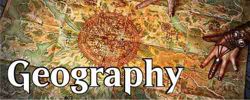 For the story of Zendikar to make a little more sense, you need to understand the geography of the plane itself. The Planeswalker’s Guides give clues as to how the plane is laid out, as does the story, but much of the geography is purposefully vague. In the Teeth of Akoum provides more clues, but a single strong roil is all it would take to render a map pointless. From a creative viewpoint, this makes sense and the story shouldn't get bogged down in travel times, but we think it's important to at least have a rudimentary understanding of how everything is laid out. In modern times there are a few regions you absolutely need to know about.
For the story of Zendikar to make a little more sense, you need to understand the geography of the plane itself. The Planeswalker’s Guides give clues as to how the plane is laid out, as does the story, but much of the geography is purposefully vague. In the Teeth of Akoum provides more clues, but a single strong roil is all it would take to render a map pointless. From a creative viewpoint, this makes sense and the story shouldn't get bogged down in travel times, but we think it's important to at least have a rudimentary understanding of how everything is laid out. In modern times there are a few regions you absolutely need to know about.
Much of the plot takes place on the continent of Akoum. Akoum is a circular continent and, like much of Zendikar, has hazardous cliffs instead of shores. Akoum lacks any kind of permanent ports, and shipwrecks are frequent. The Teeth of Akoum is an extremely mountainous region on the northern edge of the continent, and it is here that the Eldrazi were imprisoned. The key hedron that keeps the Eldrazi imprisoned, the Eye of Ugin, is located here as well. To reach the Eye, you would have to travel from Affa, a large settlement which resides at the base of the Teeth of Akoum. Akoum is also home to Fort Keff, where Gideon first encounters the Eldrazi and where his path to Battle for Zendikar begins. Also of note here is the Khalni Stone and Ora Ondar. The Khalni Stone is an intense mana prism that causes the surface above, Ora Ondar, to bloom with giant plants. Eating those plants can be dangerous, as they contain the raw, wild magic of Zendikar and mutate the elves who live there.
Near Akoum lies the subcontinent of Bala Ged, a swampy subcontinent separated from Guul Draz by a giant marsh. Although this isn’t explicitly stated, Bala Ged also connects to Akoum through underground rivers, meaning the three continents form more or less one giant continent. Due to its proximity to Akoum and thus the Eldrazi Titans when released, Bala Ged is one of the first areas of Zendikar to be lost. Bala Ged was also the home of Nissa Revane, making its loss very personal to the protagonists of the story. On the other side of that marsh lies Guul Draz, a humid, swampy continent. The largest settlement on Zendikar is located here, which is the vampire city of Malakir. Malakir itself is divided into districts, each controlled by a different vampire clan. It's proximity to Bala Ged, and by extension the Joraga Elves, keeps the two locked in a constant series of skirmishes.
Across the sea lies the continent of Tazeem. Everything about the Battle for Zendikar indicates that the majority of the plot will be occurring here. Tazeem has three regions of note: Sea Gate, Emeria and Oran-Rief. Sea Gate is the largest non-vampire settlement on Zendikar and is a major hub of civilization. The assault of Sea Gate kicks off the story of Battle for Zendikar, as it's one of the last remaining bastions of civilization remaining on the plane. Further inland you’ll find Emeria, the Sky Ruin, which is a large plain of floating land and hedrons. This area was once believed to house the sky god Em, but its true purpose and origin remain unknown. Past Emeria is Oran-Rief, the Vastwood, one of the few remaining forests not already seriously damaged by the Eldrazi.
Also across the sea is Ondu, where the story begins during the events of In the Teeth of Akoum. The plot beings in the forests of Turntimber (represented in Turntimber Grove), located in the center of the continent. Sorin and Nissa then travel through Graypelt Refuge (the largest ‘settlement’ on Ondu - but really more of a camp), and through the hazardous Makindi Trench (think Grand Canyon, but deadlier). Sorin and Nissa then take Zulaport, on the coast of Ondu, to travel across the sea. The continents of Ondu and Akoum are in fact only a short distance away from one another through a narrow sea.
There are two small continents of little relevance to the overall plot, the first of which is Murasa. Murasa is essentially the Australia of Zendikar. It’s rather remote and treacherous, but none of the main plot takes places here. It’s of interest that Kazuul, Tyrant of the Cliffs makes his home in his namesake cliffs along the shores of Murasa. Sejiri is Zendikar’s northern most polar cap. There are no permanent settlements here, and little life, so no stories take place here. Sejiri most likely lies north of Akoum, as it was one of the first continents destroyed by the Eldrazi.
If you’d like to learn more about Zendikar’s regions, make sure to check out the Planeswalker’s Guides we linked to above. We’re only really covering what geography is relevant to the story, but there is a lot more to the world than we discuss here.
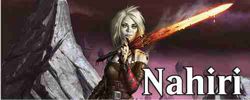 Nahiri is the infamous Lithomancer first depicted in Nahiri, the Lithomancer. Her identity was once one of the biggest mysteries in Magic. When introduced to the world of Zendikar, the players learned that the Eldrazi were sealed thousands of years ago by a trio of planeswalkers. The players knew two of their identities right away: Sorin Markov, the most fabulous of vampire planeswalkers, and Ugin, the Spirit Dragon. The third planeswalker, known only as The Lithomancer, was unknown for years. The Lithomancer was a source of speculation until finally revealed in advance if her release as a commander for the Commander 2014 product, although her name was hinted at earlier.
Nahiri is the infamous Lithomancer first depicted in Nahiri, the Lithomancer. Her identity was once one of the biggest mysteries in Magic. When introduced to the world of Zendikar, the players learned that the Eldrazi were sealed thousands of years ago by a trio of planeswalkers. The players knew two of their identities right away: Sorin Markov, the most fabulous of vampire planeswalkers, and Ugin, the Spirit Dragon. The third planeswalker, known only as The Lithomancer, was unknown for years. The Lithomancer was a source of speculation until finally revealed in advance if her release as a commander for the Commander 2014 product, although her name was hinted at earlier.
Nahiri’s stone-based magic was essential to the initial imprisoning of the Eldrazi, as she was the one to construct the Hedrons across Zendikar as a trap for the extraplanar beings. Afterwards she played the even more vital role of guardian of Zendikar. Nahiri’s role was to watch over the seals they placed on Zendikar as the Eldrazi tested their prison. However, when the time came and the Eldrazi were finally awakened, Nahiri was nowhere to be found. Sorin insinuated to Ugin that he knows where Nahiri is, but her exact fate remains unknown.
The Stoneforge Mystics are from the lineage of stoneforgers Nahiri created thousands of years ago.
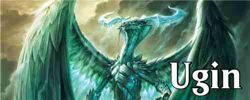 Ugin, first referenced in the flavor text of Ghostfire, was nearly as much of a mystery as Nahiri until very recently. Represented by the Eye of Ugin, speculation was rampant as to who this Spirit Dragon was and why he didn’t show up to help, information we later learned from the Khans of Tarkir block. With his recent revival, Ugin's first priority is to mitigate the damage done by the Eldrazi.
Ugin, first referenced in the flavor text of Ghostfire, was nearly as much of a mystery as Nahiri until very recently. Represented by the Eye of Ugin, speculation was rampant as to who this Spirit Dragon was and why he didn’t show up to help, information we later learned from the Khans of Tarkir block. With his recent revival, Ugin's first priority is to mitigate the damage done by the Eldrazi.
When it came time to deal with the Eldrazi, it was Ugin that urged for their imprisonment. Facing them in their native environment (the Blind Eternities) would be fatal, he argued, and killing their physical forms pointless. Further, he argued there was no telling what killing the Eldrazi would do to the multiverse. His expertise with colorless magic gave him insight into the Eldrazi, and he was the primary architect of their prison on Zendikar.
While not a capital-E Elder Dragon, Ugin is more ancient than any other known planeswalker, save Nicol Bolas.
The earliest story of Ugin, How Many Eyes, depicts an Ugin that is nothing like the one we've come to know today. It's possible that this is an alternate version of Ugin, due to the events of the Time Spiral block, but the story itself is best forgotten.
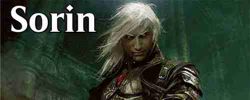 Sorin Markov was the least mysterious of the three planeswalkers who originally trapped the Eldrazi.
Sorin Markov was the least mysterious of the three planeswalkers who originally trapped the Eldrazi.
When the Eldrazi’s prison once again weakened, Sorin was the only one of the three who heeded the call. An expert in exsanguination, Sorin provided the magic that would sap the Eldrazi’s power while imprisoned. He encountered Nissa Revane upon returning to Zendikar, and enlisted her aid in strengthening the Eldrazi’s prison. When Revane instead set the Eldrazi free, he left the plane in disgust to attend to his own affairs on Innistrad. Once attended to, he set out in search of Ugin where he found the Spirit Dragon just recovering from his near-fatal encounter with Nicol Bolas over a thousand years earlier. It was not a pleasant reunion, however, as Sorin reveals that Nahiri would not be happy to see him due to something he had done in the intervening time.
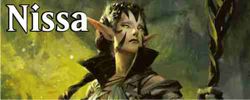 Nissa Revane is a complicated character. She was originally created to fit the green and black elf tribal deck in Duels of the Planeswalkers. In the original Zendikar block, Nissa was portrayed as a deeply xenophobic character, believing in the superiority of Elves, something her card Nissa Revane alluded to. Nissa’s background included dabbling in black magic as she had spent time with the Elves of Lorwyn. When she encountered the Eldrazi and later Sorin, all Nissa wanted was for them to be gone. She was ultimately responsible for breaking the seal on the Eldrazi Titans’ prison, to Sorin’s disgust, because she believed the Eldrazi would leave. Unfortunately, like that one stoner friend from high school who just wants to crash at your place for a couple days, the Eldrazi proceeded to stick around indefinitely and eat everything in sight.
Nissa Revane is a complicated character. She was originally created to fit the green and black elf tribal deck in Duels of the Planeswalkers. In the original Zendikar block, Nissa was portrayed as a deeply xenophobic character, believing in the superiority of Elves, something her card Nissa Revane alluded to. Nissa’s background included dabbling in black magic as she had spent time with the Elves of Lorwyn. When she encountered the Eldrazi and later Sorin, all Nissa wanted was for them to be gone. She was ultimately responsible for breaking the seal on the Eldrazi Titans’ prison, to Sorin’s disgust, because she believed the Eldrazi would leave. Unfortunately, like that one stoner friend from high school who just wants to crash at your place for a couple days, the Eldrazi proceeded to stick around indefinitely and eat everything in sight.
Having a tribal Elf planeswalker was great, for those of us who like Elf tribal, but to many players she was seen as a disappointing failure. Her ability required you to stack your deck with Nissa’s Chosen to make good use of her, and ultimately she was too limiting, especially for the new mono-green planeswalker.
So what happened? Well, the primary mono green planeswalker, Garruk Wildspeaker had been cursed around the time of the Innistrad block, an ironic twist, as Garruk was deemed unsuitable for the black-green deck in Duels of the Planeswalkers. He was hunting down Liliana and was becoming more and more affected by black mana as time went on, so he was no longer a good fit for the mono green slot. Creative knew by this point that we would be returning to Zendikar, so the seeds were planted for Nissa’s return and direction change. Rather than being all about elves, Nissa was now an elementalist. And, after Magic Origins, she’d always been an elementalist. This change is one of the many that throws the canonicity of In the Teeth of Akoum into doubt.
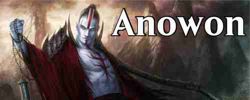 Anowon, the Ruin Sage is perhaps the most important non-planeswalker in the Zendikar story. An Archaeomancer and scholar of great reputation, Anowon’s long unlife as a vampire has allowed him to study the ruins of Zendikar in great detail. His history is chronicled in a Consortium report comissioned by Jace after the events at the Eye of Ugin. Formerly of the Ghet vampire lineage, he was cast out at some point in the past, most likely for his archeological pursuits. He serves as a guide for both Jace and Chandra as he leads them to the Eye of Ugin. In the block novel In the Teeth of Akoum, he serves as a guide to the eye again, this time for Sorin Markov and Nissa Revane.
Anowon, the Ruin Sage is perhaps the most important non-planeswalker in the Zendikar story. An Archaeomancer and scholar of great reputation, Anowon’s long unlife as a vampire has allowed him to study the ruins of Zendikar in great detail. His history is chronicled in a Consortium report comissioned by Jace after the events at the Eye of Ugin. Formerly of the Ghet vampire lineage, he was cast out at some point in the past, most likely for his archeological pursuits. He serves as a guide for both Jace and Chandra as he leads them to the Eye of Ugin. In the block novel In the Teeth of Akoum, he serves as a guide to the eye again, this time for Sorin Markov and Nissa Revane.
Anowon's magic from In the Teeth of Akoum is based around mana imbued in the teeth of creatures he killed (most commonly merfolk). In the story of Battle for Zendikar, it appears that he has become some kind of leader in the resistance against the Eldrazi.
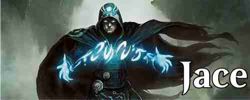 Jace’s role in the original Zendikar story is a small one, but not when it came to tournaments, but he’s been the face of Magic: the Gathering for the last 10 years and this is the first time he was part of the story of a block. Most of his actions here are preceded by the events of his book, Agents of Artifice, which isn’t associated with a specific block’s story but is an independent planeswalker story. In the story, he is primarily motivated by orders from the Consortium, and so has a rather passive role in the first Zendikar block. During his time with the Consortium, he tracked down Chandra to find a mystic scroll she had stolen, then a few years later he was influenced again to track her down to Zendikar.
Jace’s role in the original Zendikar story is a small one, but not when it came to tournaments, but he’s been the face of Magic: the Gathering for the last 10 years and this is the first time he was part of the story of a block. Most of his actions here are preceded by the events of his book, Agents of Artifice, which isn’t associated with a specific block’s story but is an independent planeswalker story. In the story, he is primarily motivated by orders from the Consortium, and so has a rather passive role in the first Zendikar block. During his time with the Consortium, he tracked down Chandra to find a mystic scroll she had stolen, then a few years later he was influenced again to track her down to Zendikar.
 Chandra’s role in the first Zendikar block was intimately tied to Jace’s: her theft of the Dragon Scroll from the Sanctum of the Stars on the plane of Kephalia, as detailed in the webcomics and the opening chapters of The Purifying Fire, brought both her and Jace to Zendikar. Jace, still at this time working for the Infinite Consortium, was tasked with retrieving the scroll. He tracked her to Keral Keep on Regatha, the closest place Chandra has to a home. They fought over the scroll, with Jace besting her. He not only reclaimed the scroll, but wiped her memory of the spell it contained: Ugin’s Ghostfire. Unknown to Jace, however, the scribes of Keral Keep had already made copies of the spell.
Chandra’s role in the first Zendikar block was intimately tied to Jace’s: her theft of the Dragon Scroll from the Sanctum of the Stars on the plane of Kephalia, as detailed in the webcomics and the opening chapters of The Purifying Fire, brought both her and Jace to Zendikar. Jace, still at this time working for the Infinite Consortium, was tasked with retrieving the scroll. He tracked her to Keral Keep on Regatha, the closest place Chandra has to a home. They fought over the scroll, with Jace besting her. He not only reclaimed the scroll, but wiped her memory of the spell it contained: Ugin’s Ghostfire. Unknown to Jace, however, the scribes of Keral Keep had already made copies of the spell.
Chandra then attempted to steal the scroll a second time. Although this attempt would end in disaster, it did cause her to cross paths with Gideon Jura. Having learned from Gideon that the scroll originated on Zendikar, Chandra travelled there to find answers. On Zendikar, she sought Anowon, hoping he could lead her to the Eye of Ugin. Though Anowon betrayed her, having long searched for the scroll himself, Sarkhan Vol would come to her aid and the two of them would travel to the Eye. There, Sarkhan attacked Chandra in his dragon form. Teaming up with Jace, who had again tracked her down, Chandra was able to use Ugin’s ghostfire to take down both Sarkhan and Jace. Unbeknownst to any of the three planeswalkers, their battle culminating in the use of ghostfire was the final key to unlocking the Eldrazi from their imprisonment, setting in motion the events of Zendikar block.
It’s important to note that Chandra first heard of the Dragon Scroll from the mad planeswalker Ramaz, who in turn was working for Nicol Bolas, as revealed in the single player campaign of Duels of the Planeswalkers 2014. The canonicity of the Duels storylines are questionable, but nothing official has contradicted Duels 2014 to date. Regardless, the original opening of the Eye was orchestrated by Bolas for an unknown purpose.
With Chandra and Jace both, it’s interesting that while they are the focus of much of the Zendikar block ancillary materials, and they both have cards in Zendikar/Worldwake, neither of them appear in the actual block novel. It seems like Wizards is taking the inverse tack now; planeswalkers can get screentime in the story without having to have cards in the block. Good thing, too, because where Jace's card was broken, Chandra Ablaze was awful.
 Gideon Jura only came across Zendikar's troubles by accident, as he tracked Chandra following the events of The Purifying Fire. Once there, however, he immediately connected with the plight of the Zendikari and vowed to help them fight the Eldrazi. After barely escaping at Fort Keff as it was razed by Emarakul's spawn (leading to an appearance by Emrakul herself) he planeswalked away to find help, knowing he would need many Planeswalkers to combat this threat. His destination? Ravnica, where he had heard of the Infinite Consortium.
Gideon Jura only came across Zendikar's troubles by accident, as he tracked Chandra following the events of The Purifying Fire. Once there, however, he immediately connected with the plight of the Zendikari and vowed to help them fight the Eldrazi. After barely escaping at Fort Keff as it was razed by Emarakul's spawn (leading to an appearance by Emrakul herself) he planeswalked away to find help, knowing he would need many Planeswalkers to combat this threat. His destination? Ravnica, where he had heard of the Infinite Consortium.
Unfortunately for Gideon, Jace’s action had already led to the destruction of the Consortium, and so Gideon worked with the Boros guild seeking justice for Ravnica while searching for allies to help him on Zendikar. It wasn’t until Ral Zarek, with the help of Jace, accidently discovered that Gideon was a planeswalker that things began to change. Jace and Ral were not stealthy enough to avoid Gideon’s notice, and so while the two planeswalkers thought they were tracking Gideon, Gideon discovered their true nature as planeswalkers. And he decided to get Jace’s help.
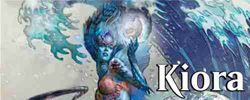 Like Nissa, Kiora was first introduced in Duels of the Planeswalkers 2012 although we wouldn’t learn her origins on Zendikar until she got her first card in Theros block. Kiora is a native of Zendikar, who has been travelling the multiverse trying to find new krakens, leviathans, and other large sea beasts to aid the fight against the Eldrazi. When she came to Theros looking for recruits, she caused a massive tsunami in Meletis and drew the attention of the local tritons, who believed she was Thassa, God of the Sea.
Like Nissa, Kiora was first introduced in Duels of the Planeswalkers 2012 although we wouldn’t learn her origins on Zendikar until she got her first card in Theros block. Kiora is a native of Zendikar, who has been travelling the multiverse trying to find new krakens, leviathans, and other large sea beasts to aid the fight against the Eldrazi. When she came to Theros looking for recruits, she caused a massive tsunami in Meletis and drew the attention of the local tritons, who believed she was Thassa, God of the Sea.
Seeing how well that deception worked out, she later impersonated the great sailor Callephe. In this disguise she met Ajani and Elspeth on their journey to the Temple of Mystery at the edge of the world. She took them on her ship with her, though she was actually trying to find the kraken Arixmethes. Thassa (the real Thassa) wouldn’t surrender control of the kraken so easily, and engaged Kiora in battle. Though she failed to capture Arixmethes, Kiora did steal the Bident of Thassa, Dekella.
Kiora’s introduction was controversial. Originally she was known as Kiora Atua, her name being derived from the Maori: “kia ora”, a greeting, and “atua”, meaning strength. Realizing after the fact that while “atua” literally translates as strength, it’s also the word for “god” or “spirit,” Wizards dropped her last name so as not to offend the real-world Maori religion. Officially she no longer has a last name, though the first release of her Funko Pop! figure was issued before the change so the name appears on the packaging.
 Sarkhan Vol’s transformation when Zendikar begins is shocking. During the story of Alara, Sarkhan guided Ajani on his way and taught him how to harness red mana, the fiery passion of his heart. Sarkhan was free, a dragon-loving planeswalker searching Jund for a dragon to call master. But when Zendikar rolls around, Sarkhan is nothing but a bit player, a pawn Nicol Bolas places to release the Eldrazi. Sarkhan threw in his lot with the wrong dragon, and he’s nothing but a shell of what we knew, represented in Sarkhan the Mad. He serves to fill the role of the third planeswalker to unlock the Eye of Ugin deep underground and then disappears from the scene, of seemingly little relevance to the plot.
Sarkhan Vol’s transformation when Zendikar begins is shocking. During the story of Alara, Sarkhan guided Ajani on his way and taught him how to harness red mana, the fiery passion of his heart. Sarkhan was free, a dragon-loving planeswalker searching Jund for a dragon to call master. But when Zendikar rolls around, Sarkhan is nothing but a bit player, a pawn Nicol Bolas places to release the Eldrazi. Sarkhan threw in his lot with the wrong dragon, and he’s nothing but a shell of what we knew, represented in Sarkhan the Mad. He serves to fill the role of the third planeswalker to unlock the Eye of Ugin deep underground and then disappears from the scene, of seemingly little relevance to the plot.
Or so we thought for years. Was Sarkhan really mad, or was he driven to madness by a Tormenting Voice that came to him during his long wait in the Eye of Ugin? As we learned in the Tarkir block story, it turns out Sarkhan was not so much insane as the vessel of a hitchhiking Ugin, something that would drive Sarkhan to Tarkir and ultimately redemption and the resurrection of the Spirit Dragon.
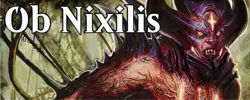 One line of flavor text on Ob Nixilis, the Fallen was all it took to spark our collective imaginations: His spark lost, he plots revenge upon the plane whose corrupting mana fracture his soul. Wait.. did you say spark? Who is this awesome demon legend, and when do we get to know more about him? It wouldn’t be for another five years that we’d learn just who Ob Nixilis is, and how big a player he would become in Zendikar’s story. Whether an intentional plant or a seized opportunity, Ob Nixilis has spawned two more cards and is looking to take center stage in the upcoming Battle for Zendikar.
One line of flavor text on Ob Nixilis, the Fallen was all it took to spark our collective imaginations: His spark lost, he plots revenge upon the plane whose corrupting mana fracture his soul. Wait.. did you say spark? Who is this awesome demon legend, and when do we get to know more about him? It wouldn’t be for another five years that we’d learn just who Ob Nixilis is, and how big a player he would become in Zendikar’s story. Whether an intentional plant or a seized opportunity, Ob Nixilis has spawned two more cards and is looking to take center stage in the upcoming Battle for Zendikar.
Once the world-conquering planeswalker Ob Nixilis of the Black Oath, Ob’s encounter with the Chain Veil cursed him to walk as a demon. Ob attempted to use the wild and powerful mana of Zendikar to cure his curse, but lost his spark instead. Nahiri, sensing the danger Ob would cause to her plane, limited his power further by implanting a power-sapping hedron into his forehead and making him a shadow of his former self. When an unnamed planeswalker removed this hedron from Ob Nixilis in order to use it on Garruk, who was suffering from the same curse, Ob happily played dead. With the hedron gone, much of his power returned and he unfurled his wings to became Ob Nixilis, Unshackled. As his adopted plane of Zendikar succumbs to the Eldrazi, Ob can begin to feel his spark again, just out of reach. He believes that all he needs to get it back now is to destroy the plane.
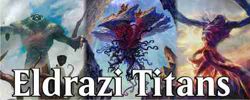 Rise of the Eldrazi was quite a shock for most players. When Ulamog, the Infinite Gyre, Emrakul, the Aeons Torn, Kozilek, Butcher of Truth arrived on scene, with appropriately Lovecraftian names, fans went crazy. Not much is known about the Eldrazi Titans. Sealed away for thousands of years, the people of Zendikar slowly forget their threat and believed them to be the gods of Zendikar. Each Eldrazi has their own brood lineage, which resemble the Titans from which they are spawned: Ulamog’s spawn generally have bisected arms and limbs and bone-link faceplates or helmets and are generally humanoid in shape. Kozilek’s spawn typically resemble sea creatures or animals with abstract or floating shapes. Emrakul’s spawn typically fly or are more amorphous than the others.
Rise of the Eldrazi was quite a shock for most players. When Ulamog, the Infinite Gyre, Emrakul, the Aeons Torn, Kozilek, Butcher of Truth arrived on scene, with appropriately Lovecraftian names, fans went crazy. Not much is known about the Eldrazi Titans. Sealed away for thousands of years, the people of Zendikar slowly forget their threat and believed them to be the gods of Zendikar. Each Eldrazi has their own brood lineage, which resemble the Titans from which they are spawned: Ulamog’s spawn generally have bisected arms and limbs and bone-link faceplates or helmets and are generally humanoid in shape. Kozilek’s spawn typically resemble sea creatures or animals with abstract or floating shapes. Emrakul’s spawn typically fly or are more amorphous than the others.
The Eldrazi’s role as gods was an inadvertent mistake by Nahiri. When trying to explain their concept to her people, she referred to them as gods, but eventually their fear turned to worship, and the Eldrazi were adopted as gods of Zendikar in myth. The Merfolk and Kor knew them by different names. Ulamog was known as Ula to the Merfolk or Mangeni to the Kor, the God of the Sea. Emrakul was known as Em or Emera and Kamsa to the Kor, the God of the Sky. Kozilek was known as Cosi to the Merfolk, a trickster god of the land. Among the Kor, he was Talib, god of the earth.
A lot of what was once known about the Eldrazi by the people of Zendikar proves no longer true. Many of the ruins thought to be Eldrazi artifacts were in fact simply the remnants of the ancient Zendikari civilizations that were destroyed by the Eldrazi or the Roils. They could also be the remnants of the Hedron Network, important sites where Ugin, Sorin and Nahiri built temples or other structures to protect. It’s still unclear why the Eldrazi built anything, but it’s possible that during a weakening of the prison, the Eldrazi did not act as devourers but tried to influence the world to help win their true freedom. It’s also possible that creative has simply retconned these ancient ruins.
Aiding the Eldrazi are Zendikar's vampires. It's unclear how vampires first camp to be on the plane, but what is known is that the Titans enslaved the vampires and bestowed upon them vestigial elbow and shoulder horns, for easy handling. The purpose of having these slaves is unclear, but explanations from In the Teeth of Akoum mentioned that the vampires served as mana distillers, brewing up the hard stuff for their brood lineage masters. Modern day vampires are incredibly defiant against their former masters, although many have been once more enslaved.
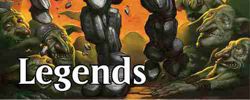 Not every story of Zendikar is critical to the understanding of the Eldrazi, legends of very different statures have their own stories to tell. Some have short stories that tell the tales of less important characters, and some we only have a few lines of flavor text and artwork to go on.
Not every story of Zendikar is critical to the understanding of the Eldrazi, legends of very different statures have their own stories to tell. Some have short stories that tell the tales of less important characters, and some we only have a few lines of flavor text and artwork to go on.
Tuktuk the Explorer & Tuktuk the Returned
You can explore Tuk Tuk's story in The Tale of Tuktuk. Tuktuk’s character transforms from a measly Goblin Explorer to the beefy Tuktuk the Returned, a golem powerful enough to hold his own in most fights. Tuktuk was a stupid Goblin like any other, and one day he decided that he would become a legend among the goblins. To do so, he would have to find an artifact unlike any before seen by Goblinkind. Tuk Tuk found his relic, a powerful hedron unlike any he had seen before, but when he laid hands on it a rune trap was sprung and promptly killed him and destroyed his prize, splattering him all over the walls of the ruin. But the magic of the destroyed hedron released some Eldrazi power, and when the Hedron network tried to reform the Hedron, Tuk Tuk’s mind was caught in the middle and reborn as a Stone Golem made of the former Hedron. Tuktuk returned to his clan, where he was promptly made chief.
Tuktuk the Returned has the dubious honor of the most type and subtypes in Magic: he is a Legendary Token Artifact Creature - Goblin Golem. We anxiously await his return once more in Battle for Zendikar.
A Tuk Tuk also happens to be the name of a type of rickshaw-like taxi found in southeast Asia.
Kazuul, Tyrant of the Cliffs
Kazuul is a powerful ogre that controls the entry to Murasa, as discussed in The Tyrant of the Cliffs. The Cliffs of Kazuul share his name for good reason: either you pay up to enter, or you become his slave. So far, smart people pay. Unfortunately for Kazuul, however, it’s unlikely that survived very long into the Eldrazi’s onslaught, as by Rise of the Eldrazi a nameless elf has claimed his weapon, and by the flavor text has apparently taken over his role.
Kazuul's story is the only one to take place on the continent of Murasa.
Omnath, Locus of Mana
The continent of Ondu holds the Prison of Omnath. Omnath was kept imprisoned by regular rituals known as the festival of lights, renewing the binding circle of his prison. During the events leading up to the Rise of the Eldrazi, however, the ritual was disrupted and Omnath set loose. Omnath represents the wild and chaotic mana of Zendikar come to life, and by the time of Battle for Zendikar, he is a little mad. A little of Omnath's awakening is discussed in Worldwake: A Plane in Revolt.
Linvala, Keeper of Silence & Iona, Shield of Emeria
While most angels of Zendikar wore their halos over their eyes to symbolize their blindness to the Eldrazi’s atrocities, these two great angels retained their sight and stood vigil.
Thada Adel, Acquisitor
There is less to go on for Thada than any other legend in this block, but we like to imagine her as the merfolk version of Indiana Jones. Her art evokes the classic opening from Raiders of the Lost Ark, as she prepared to take a valuable artifact off an obviously trapped pedestal. We’re wondering if she ever got caught in a Cobra Trap, would she declare how much she hates snakes?
Drana, Kalastria Bloodchief & Kalitas, Bloodchief of Ghet
Bloodchiefs are the leaders of the various vampire lineages on Zendikar. Ghet is an impoverished clan while Kalastria does pretty well for itself these days, although those days of bloodline rivalry have taken a back seat to the fight against the Eldrazi. These Bloodchiefs are the only vampires who can create more vampires, an ability represented on Kalitas. The rest can only create Nulls.
Wrexial, the Risen Deep
Wrexial is a bit of an ironic card, and his design is classic Cthulhu in a block about Lovecraftian horrors. Not much is known about Wrexial, but here is hoping for a card depicting his battle against Eldrazi in Battle for Zendikar, hopefully by Kiora's side.
Lorthos, the Tidemaker
Also known as the Freshmaker, Lorthos is a Legend of the Deep, and apparently a very popular card among R&D. Flavorfully, he's a beautiful card as he taps one permanent per tentacle. A little tidbit about Lorthos: Quest for Ula’s Temple actually had to be changed because of Lorthos. His design as an Octopus necessitated the addition of Octopi to the quest. Presumably Kiora and Lorthos are already BFFs on Zendikar, but only time will tell.
Archive Trap
We would be remiss if we didn’t talk about our namesake, the card Archive Trap. Archive Trap was card from Zendikar that originally began as Mill Trap. It’s remarkable in that it’s one of a few cards that gets no changes from design to print, although in design itself it started as a Cranial Extraction-like effect. Card itself has a little bit of story behind it, as it tells the tale of an explorer who bought a map to a valuable archive with thousands of books and scrolls. Unfortunately for this explorer, however, the moment he touched one the entire place came down around his head, Aladdin-style.
That’s it for this week, thanks for reading! We hope this article got you caught up on the world and players of the Zendikar story, in preparation for Part II. Next week we bring you all the juicy details of the plot, leading us right up to the end of Rise of the Eldrazi! Part II Available Here
Did we miss anything? Let us know in the comments, and we’ll address it in future updates. Have a suggestion for something you’d like to see? Let us know, and we could address it in a future column. As always, you can check out our Wiki to learn more.
Zendikar is the subject of numerous Planeswalker's Guides. These guides are relatively short but provide a lot of great context about the plane itself and the flavor of the world. We highly recommend that if you skip every other article, you read through these:
- A Planeswalker’s Guide to Zendikar
- The Journal of Javad Nasrin
- A Planeswalker’s Guide to Zendikar: Guul Draz & Vampires
- A Planeswalker’s Guide to Zendikar: Ondu
- A Planeswalker’s Guide to Zendikar: Tazeem & Merfolk
- A Planeswalker’s Guide to Zendikar: Goblins
- A Planeswalker’s Guide to Zendikar: Akoum
- A Planeswalker’s Guide to Zendikar: Murasa & Sejiri
- A Planeswalker's Guide to Zendikar: Bala Ged & Elves
- The Eldrazi Arisen
- Rise of the Eldrazi: Gods and Monsters
- Rise of the Eldrazi: The Defiance of Angels
- Rise of the Eldrazi: The Three Brood Lineages

Much of the plot takes place on the continent of Akoum. Akoum is a circular continent and, like much of Zendikar, has hazardous cliffs instead of shores. Akoum lacks any kind of permanent ports, and shipwrecks are frequent. The Teeth of Akoum is an extremely mountainous region on the northern edge of the continent, and it is here that the Eldrazi were imprisoned. The key hedron that keeps the Eldrazi imprisoned, the Eye of Ugin, is located here as well. To reach the Eye, you would have to travel from Affa, a large settlement which resides at the base of the Teeth of Akoum. Akoum is also home to Fort Keff, where Gideon first encounters the Eldrazi and where his path to Battle for Zendikar begins. Also of note here is the Khalni Stone and Ora Ondar. The Khalni Stone is an intense mana prism that causes the surface above, Ora Ondar, to bloom with giant plants. Eating those plants can be dangerous, as they contain the raw, wild magic of Zendikar and mutate the elves who live there.
Near Akoum lies the subcontinent of Bala Ged, a swampy subcontinent separated from Guul Draz by a giant marsh. Although this isn’t explicitly stated, Bala Ged also connects to Akoum through underground rivers, meaning the three continents form more or less one giant continent. Due to its proximity to Akoum and thus the Eldrazi Titans when released, Bala Ged is one of the first areas of Zendikar to be lost. Bala Ged was also the home of Nissa Revane, making its loss very personal to the protagonists of the story. On the other side of that marsh lies Guul Draz, a humid, swampy continent. The largest settlement on Zendikar is located here, which is the vampire city of Malakir. Malakir itself is divided into districts, each controlled by a different vampire clan. It's proximity to Bala Ged, and by extension the Joraga Elves, keeps the two locked in a constant series of skirmishes.
Across the sea lies the continent of Tazeem. Everything about the Battle for Zendikar indicates that the majority of the plot will be occurring here. Tazeem has three regions of note: Sea Gate, Emeria and Oran-Rief. Sea Gate is the largest non-vampire settlement on Zendikar and is a major hub of civilization. The assault of Sea Gate kicks off the story of Battle for Zendikar, as it's one of the last remaining bastions of civilization remaining on the plane. Further inland you’ll find Emeria, the Sky Ruin, which is a large plain of floating land and hedrons. This area was once believed to house the sky god Em, but its true purpose and origin remain unknown. Past Emeria is Oran-Rief, the Vastwood, one of the few remaining forests not already seriously damaged by the Eldrazi.
Also across the sea is Ondu, where the story begins during the events of In the Teeth of Akoum. The plot beings in the forests of Turntimber (represented in Turntimber Grove), located in the center of the continent. Sorin and Nissa then travel through Graypelt Refuge (the largest ‘settlement’ on Ondu - but really more of a camp), and through the hazardous Makindi Trench (think Grand Canyon, but deadlier). Sorin and Nissa then take Zulaport, on the coast of Ondu, to travel across the sea. The continents of Ondu and Akoum are in fact only a short distance away from one another through a narrow sea.
There are two small continents of little relevance to the overall plot, the first of which is Murasa. Murasa is essentially the Australia of Zendikar. It’s rather remote and treacherous, but none of the main plot takes places here. It’s of interest that Kazuul, Tyrant of the Cliffs makes his home in his namesake cliffs along the shores of Murasa. Sejiri is Zendikar’s northern most polar cap. There are no permanent settlements here, and little life, so no stories take place here. Sejiri most likely lies north of Akoum, as it was one of the first continents destroyed by the Eldrazi.
If you’d like to learn more about Zendikar’s regions, make sure to check out the Planeswalker’s Guides we linked to above. We’re only really covering what geography is relevant to the story, but there is a lot more to the world than we discuss here.

Nahiri’s stone-based magic was essential to the initial imprisoning of the Eldrazi, as she was the one to construct the Hedrons across Zendikar as a trap for the extraplanar beings. Afterwards she played the even more vital role of guardian of Zendikar. Nahiri’s role was to watch over the seals they placed on Zendikar as the Eldrazi tested their prison. However, when the time came and the Eldrazi were finally awakened, Nahiri was nowhere to be found. Sorin insinuated to Ugin that he knows where Nahiri is, but her exact fate remains unknown.
The Stoneforge Mystics are from the lineage of stoneforgers Nahiri created thousands of years ago.

When it came time to deal with the Eldrazi, it was Ugin that urged for their imprisonment. Facing them in their native environment (the Blind Eternities) would be fatal, he argued, and killing their physical forms pointless. Further, he argued there was no telling what killing the Eldrazi would do to the multiverse. His expertise with colorless magic gave him insight into the Eldrazi, and he was the primary architect of their prison on Zendikar.
While not a capital-E Elder Dragon, Ugin is more ancient than any other known planeswalker, save Nicol Bolas.
The earliest story of Ugin, How Many Eyes, depicts an Ugin that is nothing like the one we've come to know today. It's possible that this is an alternate version of Ugin, due to the events of the Time Spiral block, but the story itself is best forgotten.

When the Eldrazi’s prison once again weakened, Sorin was the only one of the three who heeded the call. An expert in exsanguination, Sorin provided the magic that would sap the Eldrazi’s power while imprisoned. He encountered Nissa Revane upon returning to Zendikar, and enlisted her aid in strengthening the Eldrazi’s prison. When Revane instead set the Eldrazi free, he left the plane in disgust to attend to his own affairs on Innistrad. Once attended to, he set out in search of Ugin where he found the Spirit Dragon just recovering from his near-fatal encounter with Nicol Bolas over a thousand years earlier. It was not a pleasant reunion, however, as Sorin reveals that Nahiri would not be happy to see him due to something he had done in the intervening time.

Having a tribal Elf planeswalker was great, for those of us who like Elf tribal, but to many players she was seen as a disappointing failure. Her ability required you to stack your deck with Nissa’s Chosen to make good use of her, and ultimately she was too limiting, especially for the new mono-green planeswalker.
So what happened? Well, the primary mono green planeswalker, Garruk Wildspeaker had been cursed around the time of the Innistrad block, an ironic twist, as Garruk was deemed unsuitable for the black-green deck in Duels of the Planeswalkers. He was hunting down Liliana and was becoming more and more affected by black mana as time went on, so he was no longer a good fit for the mono green slot. Creative knew by this point that we would be returning to Zendikar, so the seeds were planted for Nissa’s return and direction change. Rather than being all about elves, Nissa was now an elementalist. And, after Magic Origins, she’d always been an elementalist. This change is one of the many that throws the canonicity of In the Teeth of Akoum into doubt.

Anowon's magic from In the Teeth of Akoum is based around mana imbued in the teeth of creatures he killed (most commonly merfolk). In the story of Battle for Zendikar, it appears that he has become some kind of leader in the resistance against the Eldrazi.


Chandra then attempted to steal the scroll a second time. Although this attempt would end in disaster, it did cause her to cross paths with Gideon Jura. Having learned from Gideon that the scroll originated on Zendikar, Chandra travelled there to find answers. On Zendikar, she sought Anowon, hoping he could lead her to the Eye of Ugin. Though Anowon betrayed her, having long searched for the scroll himself, Sarkhan Vol would come to her aid and the two of them would travel to the Eye. There, Sarkhan attacked Chandra in his dragon form. Teaming up with Jace, who had again tracked her down, Chandra was able to use Ugin’s ghostfire to take down both Sarkhan and Jace. Unbeknownst to any of the three planeswalkers, their battle culminating in the use of ghostfire was the final key to unlocking the Eldrazi from their imprisonment, setting in motion the events of Zendikar block.
It’s important to note that Chandra first heard of the Dragon Scroll from the mad planeswalker Ramaz, who in turn was working for Nicol Bolas, as revealed in the single player campaign of Duels of the Planeswalkers 2014. The canonicity of the Duels storylines are questionable, but nothing official has contradicted Duels 2014 to date. Regardless, the original opening of the Eye was orchestrated by Bolas for an unknown purpose.
With Chandra and Jace both, it’s interesting that while they are the focus of much of the Zendikar block ancillary materials, and they both have cards in Zendikar/Worldwake, neither of them appear in the actual block novel. It seems like Wizards is taking the inverse tack now; planeswalkers can get screentime in the story without having to have cards in the block. Good thing, too, because where Jace's card was broken, Chandra Ablaze was awful.

Unfortunately for Gideon, Jace’s action had already led to the destruction of the Consortium, and so Gideon worked with the Boros guild seeking justice for Ravnica while searching for allies to help him on Zendikar. It wasn’t until Ral Zarek, with the help of Jace, accidently discovered that Gideon was a planeswalker that things began to change. Jace and Ral were not stealthy enough to avoid Gideon’s notice, and so while the two planeswalkers thought they were tracking Gideon, Gideon discovered their true nature as planeswalkers. And he decided to get Jace’s help.

Seeing how well that deception worked out, she later impersonated the great sailor Callephe. In this disguise she met Ajani and Elspeth on their journey to the Temple of Mystery at the edge of the world. She took them on her ship with her, though she was actually trying to find the kraken Arixmethes. Thassa (the real Thassa) wouldn’t surrender control of the kraken so easily, and engaged Kiora in battle. Though she failed to capture Arixmethes, Kiora did steal the Bident of Thassa, Dekella.
Kiora’s introduction was controversial. Originally she was known as Kiora Atua, her name being derived from the Maori: “kia ora”, a greeting, and “atua”, meaning strength. Realizing after the fact that while “atua” literally translates as strength, it’s also the word for “god” or “spirit,” Wizards dropped her last name so as not to offend the real-world Maori religion. Officially she no longer has a last name, though the first release of her Funko Pop! figure was issued before the change so the name appears on the packaging.

Or so we thought for years. Was Sarkhan really mad, or was he driven to madness by a Tormenting Voice that came to him during his long wait in the Eye of Ugin? As we learned in the Tarkir block story, it turns out Sarkhan was not so much insane as the vessel of a hitchhiking Ugin, something that would drive Sarkhan to Tarkir and ultimately redemption and the resurrection of the Spirit Dragon.

Once the world-conquering planeswalker Ob Nixilis of the Black Oath, Ob’s encounter with the Chain Veil cursed him to walk as a demon. Ob attempted to use the wild and powerful mana of Zendikar to cure his curse, but lost his spark instead. Nahiri, sensing the danger Ob would cause to her plane, limited his power further by implanting a power-sapping hedron into his forehead and making him a shadow of his former self. When an unnamed planeswalker removed this hedron from Ob Nixilis in order to use it on Garruk, who was suffering from the same curse, Ob happily played dead. With the hedron gone, much of his power returned and he unfurled his wings to became Ob Nixilis, Unshackled. As his adopted plane of Zendikar succumbs to the Eldrazi, Ob can begin to feel his spark again, just out of reach. He believes that all he needs to get it back now is to destroy the plane.

The Eldrazi’s role as gods was an inadvertent mistake by Nahiri. When trying to explain their concept to her people, she referred to them as gods, but eventually their fear turned to worship, and the Eldrazi were adopted as gods of Zendikar in myth. The Merfolk and Kor knew them by different names. Ulamog was known as Ula to the Merfolk or Mangeni to the Kor, the God of the Sea. Emrakul was known as Em or Emera and Kamsa to the Kor, the God of the Sky. Kozilek was known as Cosi to the Merfolk, a trickster god of the land. Among the Kor, he was Talib, god of the earth.
A lot of what was once known about the Eldrazi by the people of Zendikar proves no longer true. Many of the ruins thought to be Eldrazi artifacts were in fact simply the remnants of the ancient Zendikari civilizations that were destroyed by the Eldrazi or the Roils. They could also be the remnants of the Hedron Network, important sites where Ugin, Sorin and Nahiri built temples or other structures to protect. It’s still unclear why the Eldrazi built anything, but it’s possible that during a weakening of the prison, the Eldrazi did not act as devourers but tried to influence the world to help win their true freedom. It’s also possible that creative has simply retconned these ancient ruins.
Aiding the Eldrazi are Zendikar's vampires. It's unclear how vampires first camp to be on the plane, but what is known is that the Titans enslaved the vampires and bestowed upon them vestigial elbow and shoulder horns, for easy handling. The purpose of having these slaves is unclear, but explanations from In the Teeth of Akoum mentioned that the vampires served as mana distillers, brewing up the hard stuff for their brood lineage masters. Modern day vampires are incredibly defiant against their former masters, although many have been once more enslaved.

Tuktuk the Explorer & Tuktuk the Returned
You can explore Tuk Tuk's story in The Tale of Tuktuk. Tuktuk’s character transforms from a measly Goblin Explorer to the beefy Tuktuk the Returned, a golem powerful enough to hold his own in most fights. Tuktuk was a stupid Goblin like any other, and one day he decided that he would become a legend among the goblins. To do so, he would have to find an artifact unlike any before seen by Goblinkind. Tuk Tuk found his relic, a powerful hedron unlike any he had seen before, but when he laid hands on it a rune trap was sprung and promptly killed him and destroyed his prize, splattering him all over the walls of the ruin. But the magic of the destroyed hedron released some Eldrazi power, and when the Hedron network tried to reform the Hedron, Tuk Tuk’s mind was caught in the middle and reborn as a Stone Golem made of the former Hedron. Tuktuk returned to his clan, where he was promptly made chief.
Tuktuk the Returned has the dubious honor of the most type and subtypes in Magic: he is a Legendary Token Artifact Creature - Goblin Golem. We anxiously await his return once more in Battle for Zendikar.
A Tuk Tuk also happens to be the name of a type of rickshaw-like taxi found in southeast Asia.
Kazuul, Tyrant of the Cliffs
Kazuul is a powerful ogre that controls the entry to Murasa, as discussed in The Tyrant of the Cliffs. The Cliffs of Kazuul share his name for good reason: either you pay up to enter, or you become his slave. So far, smart people pay. Unfortunately for Kazuul, however, it’s unlikely that survived very long into the Eldrazi’s onslaught, as by Rise of the Eldrazi a nameless elf has claimed his weapon, and by the flavor text has apparently taken over his role.
Kazuul's story is the only one to take place on the continent of Murasa.
Omnath, Locus of Mana
The continent of Ondu holds the Prison of Omnath. Omnath was kept imprisoned by regular rituals known as the festival of lights, renewing the binding circle of his prison. During the events leading up to the Rise of the Eldrazi, however, the ritual was disrupted and Omnath set loose. Omnath represents the wild and chaotic mana of Zendikar come to life, and by the time of Battle for Zendikar, he is a little mad. A little of Omnath's awakening is discussed in Worldwake: A Plane in Revolt.
Linvala, Keeper of Silence & Iona, Shield of Emeria
While most angels of Zendikar wore their halos over their eyes to symbolize their blindness to the Eldrazi’s atrocities, these two great angels retained their sight and stood vigil.
Thada Adel, Acquisitor
There is less to go on for Thada than any other legend in this block, but we like to imagine her as the merfolk version of Indiana Jones. Her art evokes the classic opening from Raiders of the Lost Ark, as she prepared to take a valuable artifact off an obviously trapped pedestal. We’re wondering if she ever got caught in a Cobra Trap, would she declare how much she hates snakes?
Drana, Kalastria Bloodchief & Kalitas, Bloodchief of Ghet
Bloodchiefs are the leaders of the various vampire lineages on Zendikar. Ghet is an impoverished clan while Kalastria does pretty well for itself these days, although those days of bloodline rivalry have taken a back seat to the fight against the Eldrazi. These Bloodchiefs are the only vampires who can create more vampires, an ability represented on Kalitas. The rest can only create Nulls.
Wrexial, the Risen Deep
Wrexial is a bit of an ironic card, and his design is classic Cthulhu in a block about Lovecraftian horrors. Not much is known about Wrexial, but here is hoping for a card depicting his battle against Eldrazi in Battle for Zendikar, hopefully by Kiora's side.
Lorthos, the Tidemaker
Also known as the Freshmaker, Lorthos is a Legend of the Deep, and apparently a very popular card among R&D. Flavorfully, he's a beautiful card as he taps one permanent per tentacle. A little tidbit about Lorthos: Quest for Ula’s Temple actually had to be changed because of Lorthos. His design as an Octopus necessitated the addition of Octopi to the quest. Presumably Kiora and Lorthos are already BFFs on Zendikar, but only time will tell.
Archive Trap
We would be remiss if we didn’t talk about our namesake, the card Archive Trap. Archive Trap was card from Zendikar that originally began as Mill Trap. It’s remarkable in that it’s one of a few cards that gets no changes from design to print, although in design itself it started as a Cranial Extraction-like effect. Card itself has a little bit of story behind it, as it tells the tale of an explorer who bought a map to a valuable archive with thousands of books and scrolls. Unfortunately for this explorer, however, the moment he touched one the entire place came down around his head, Aladdin-style.
That’s it for this week, thanks for reading! We hope this article got you caught up on the world and players of the Zendikar story, in preparation for Part II. Next week we bring you all the juicy details of the plot, leading us right up to the end of Rise of the Eldrazi! Part II Available Here
Did we miss anything? Let us know in the comments, and we’ll address it in future updates. Have a suggestion for something you’d like to see? Let us know, and we could address it in a future column. As always, you can check out our Wiki to learn more.
-
View User Profile
-
Send Message
Posted Sep 21, 2015Edit: I was wrong, check below for more.
-
View User Profile
-
Send Message
Posted Sep 22, 2015The Moon Kraken (the character you're talking about) doesn't seem to have much in common with Lorthos other than being a sea creature (he's much smaller, for one thing), and if Lorthos had started out as a Kraken I might be inclined to think it got changed after the book was written, but the articles I link to here say he started as an Octopus. In addition, Speaker Sutina was a Tajuru elf (Nissa was on a kind of Mission with them), and the small story with Lorthos indicates he's on the coast of Ondu, while the Moon Kraken was on the coast of Akoum. But, frankly, I don't trust anything from In the Teeth of Akoum anyway, which I'll explain in the next article.
Now, don't get me wrong, I wish In the Teeth of Akoum had a cameo like that, but we're talking about a book that gets the main character's name wrong on the first page
We discuss the plot in parts II and II, where we talk about the block novel in detail
-
View User Profile
-
Send Message
Posted Sep 22, 2015I also hastily checked for Sutina's affiliation and the wiki mistakenly labels her as a Joraga leader. Thank you for giving me a reason to revisit the information and good luck with this! I'll likely be sharing each installment.
-
View User Profile
-
Send Message
Posted Sep 22, 2015I know I made an error about Nissa's origin from DOTP 2012. It should have been the original DOTP.
-
View User Profile
-
Send Message
Posted Sep 21, 2015-
View User Profile
-
Send Message
Posted Sep 19, 2015-
View User Profile
-
Send Message
Posted Sep 20, 2015Sorry for the typos!